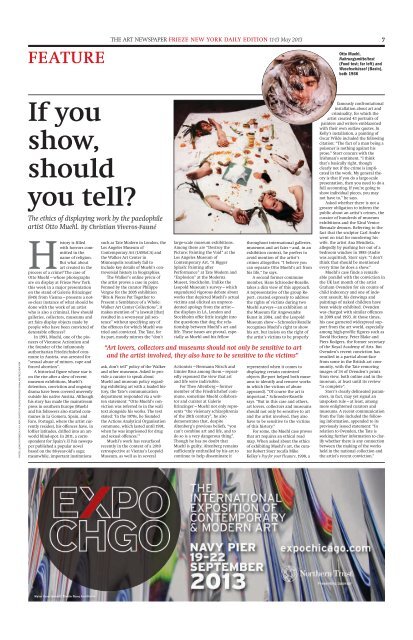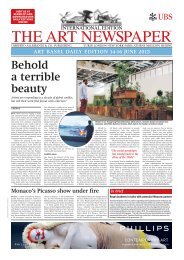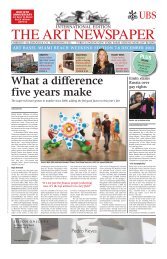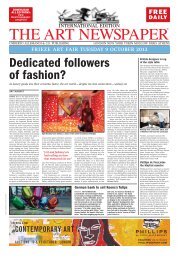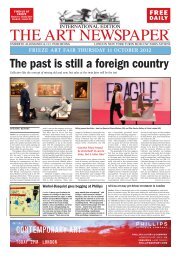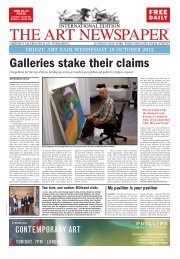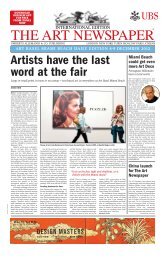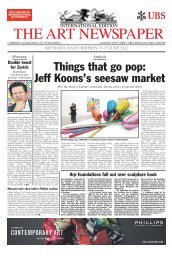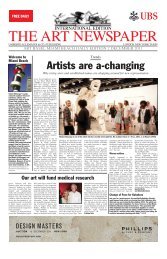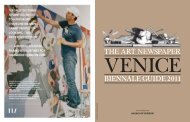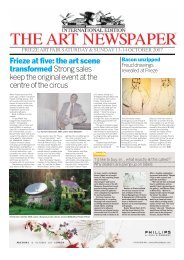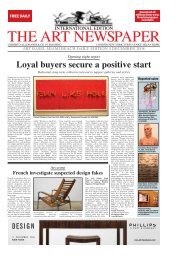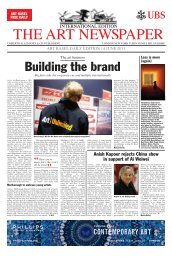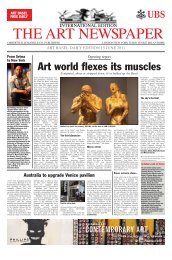frieze new york 2013, issue 2 - The Art Newspaper
frieze new york 2013, issue 2 - The Art Newspaper
frieze new york 2013, issue 2 - The Art Newspaper
You also want an ePaper? Increase the reach of your titles
YUMPU automatically turns print PDFs into web optimized ePapers that Google loves.
FEATURE<br />
THE ART NEWSPAPER FRIEZE NEW YORK DAILY EDITION 11-13 May <strong>2013</strong> 7<br />
Otto Muehl,<br />
Nahrungsmitteltest<br />
(Food test; far left) and<br />
Waschschüssel (Basin),<br />
both 1966<br />
PHOTOS: LUDWIG HOFFENREICH; © K.H. HEIN; COURTESY OF GALERIE KRINZINGER, VIENNA, AND FRIEZE NEW YORK<br />
If you<br />
show,<br />
should<br />
you tell?<br />
<strong>The</strong> ethics of displaying work by the paedophile<br />
artist Otto Muehl. By Christian Viveros-Fauné<br />
History is filled<br />
with horrors committed<br />
in the<br />
name of religion.<br />
But what about<br />
art created in the<br />
process of a crime? <strong>The</strong> case of<br />
Otto Muehl—whose photographs<br />
are on display at Frieze New York<br />
this week in a major presentation<br />
on the stand of Galerie Krinzinger<br />
(B45) from Vienna—presents a notso-clear<br />
instance of what should be<br />
done with the work of an artist<br />
who is also a criminal. How should<br />
galleries, collectors, museums and<br />
art fairs display objects made by<br />
people who have been convicted of<br />
detestable offences?<br />
In 1991, Muehl, one of the pioneers<br />
of Viennese Actionism and<br />
the founder of the infamously<br />
authoritarian Friedrichshof commune<br />
in Austria, was arrested for<br />
“sexual abuse of minors, rape and<br />
forced abortion”.<br />
A historical figure whose star is<br />
on the rise after a slew of recent<br />
museum exhibitions, Muehl’s<br />
detention, conviction and ongoing<br />
drama have been covered unevenly<br />
outside his native Austria. Although<br />
his story has made the mainstream<br />
press in southern Europe (Muehl<br />
and his followers also started communes<br />
in La Gomera, Spain, and<br />
Faro, Portugal, where the artist currently<br />
resides), his offences have, in<br />
loftier latitudes, drifted into an artworld<br />
blind-spot. In 2011, a correspondent<br />
for Spain’s El País <strong>new</strong>spaper<br />
published a popular novel<br />
based on the 88-year-old’s saga;<br />
meanwhile, important institutions<br />
such as Tate Modern in London, the<br />
Los Angeles Museum of<br />
Contemporary <strong>Art</strong> (LAMoCA) and<br />
the Walker <strong>Art</strong> Center in<br />
Minneapolis routinely fail to<br />
include key details of Muehl’s controversial<br />
history in biographies.<br />
<strong>The</strong> Walker’s online précis of<br />
the artist proves a case in point.<br />
Penned by the curator Philippe<br />
Vergne for the 2005 exhibition<br />
“Bits & Pieces Put Together to<br />
Present a Semblance of a Whole:<br />
Walker <strong>Art</strong> Center Collections”, it<br />
makes mention of “a lawsuit [that]<br />
resulted in a seven-year jail sentence”<br />
without specifying any of<br />
the offences for which Muehl was<br />
tried and convicted. <strong>The</strong> Tate, for<br />
its part, mostly mirrors the “don’t<br />
ask, don’t tell” policy of the Walker<br />
and other museums. Asked to provide<br />
a curator to speak about<br />
Muehl and museum policy regarding<br />
exhibiting art with a loaded history,<br />
the Tate’s communication<br />
department responded via a written<br />
statement: “Otto Muehl’s conviction<br />
was referred to in the wall<br />
text alongside his works. <strong>The</strong> text<br />
stated: ‘In the 1970s, he founded<br />
the Actions Analytical Organisation<br />
commune, which lasted until 1991,<br />
when he was imprisoned for drug<br />
and sexual offences.’”<br />
Muehl’s work has resurfaced<br />
recently in the context of a 2010<br />
retrospective at Vienna’s Leopold<br />
Museum, as well as in several<br />
large-scale museum exhibitions.<br />
Among these are “Destroy the<br />
Picture: Painting the Void” at the<br />
Los Angeles Museum of<br />
Contemporary <strong>Art</strong>, “A Bigger<br />
Splash: Painting after<br />
Performance” at Tate Modern and<br />
“Explosion” at the Moderna<br />
Museet, Stockholm. Unlike the<br />
Leopold Museum’s survey—which<br />
engendered vigorous debate about<br />
works that depicted Muehl’s actual<br />
victims and elicited an unprecedented<br />
apology from the artist—<br />
the displays in LA, London and<br />
Stockholm offer little insight into<br />
the questions that dog the relationship<br />
between Muehl’s art and<br />
life. <strong>The</strong>se <strong>issue</strong>s are pivotal, especially<br />
as Muehl and his fellow<br />
Actionists—Hermann Nitsch and<br />
Günter Brus among them—repeatedly<br />
espoused the view that art<br />
and life were indivisible.<br />
For <strong>The</strong>o Altenberg—former<br />
member of the Friedrichshof commune,<br />
sometime Muehl collaborator<br />
and curator at Galerie<br />
Krinzinger—Muehl not only represents<br />
“the visionary schizophrenia<br />
of the 20th century”, he also<br />
demonstrates that, despite<br />
Altenberg’s previous beliefs, “you<br />
can’t combine art and life, and to<br />
do so is a very dangerous thing”.<br />
Though he has no doubt that<br />
Muehl is guilty, Altenberg remains<br />
sufficiently enthralled by his art to<br />
continue to help disseminate it<br />
throughout international galleries,<br />
museums and art fairs—and, in an<br />
exhibition context, he prefers to<br />
avoid mention of the artist’s<br />
crimes altogether. “I believe you<br />
can separate Otto Muehl’s art from<br />
his life,” he says.<br />
A second former commune<br />
member, Hans Schroeder-Rozelle,<br />
takes a dim view of this approach.<br />
A representative of the group Report,<br />
created expressly to address<br />
the rights of victims during two<br />
Muehl surveys—an exhibition at<br />
the Museum für Angewandte<br />
Kunst in 2004, and the Leopold<br />
Museum show—Schroeder-Rozelle<br />
recognises Muehl’s right to show<br />
his art, but insists on the right of<br />
the artist’s victims to be properly<br />
“<strong>Art</strong> lovers, collectors and museums should not only be sensitive to art<br />
and the artist involved, they also have to be sensitive to the victims”<br />
represented when it comes to<br />
displaying certain contested<br />
objects (Re-port helped both museums<br />
to identify and remove works<br />
in which the victims of abuse<br />
appeared). “Of course the art is<br />
important,” Schroeder-Rozelle<br />
says. “But in this case and others,<br />
art lovers, collectors and museums<br />
should not only be sensitive to art<br />
and the artist involved, they also<br />
have to be sensitive to the victims<br />
of this history.”<br />
For some, the Muehl case proves<br />
that art requires an ethical road<br />
map. When asked about the ethics<br />
of exhibiting Muehl’s art, the curator<br />
Robert Storr recalls Mike<br />
Kelley’s Pay for your Pleasure, 1998, a<br />
famously confrontational<br />
installation about art and<br />
criminality, for which the<br />
artist created 43 portraits of<br />
painters and writers emblazoned<br />
with their own outlaw quotes. In<br />
Kelly’s installation, a painting of<br />
Oscar Wilde included the following<br />
citation: “<strong>The</strong> fact of a man being a<br />
poisoner is nothing against his<br />
prose.” Storr concurs with the<br />
Irishman’s sentiment. “I think<br />
that’s basically right, though<br />
clearly not if the crime is implicated<br />
in the work. My general theory<br />
is that if you do a large-scale<br />
presentation, then you need to do a<br />
full accounting. If you’re going to<br />
show individual pieces, you may<br />
not have to,” he says.<br />
Asked whether there is not a<br />
greater obligation to inform the<br />
public about an artist’s crimes, the<br />
curator of hundreds of museum<br />
exhibitions and the 52nd Venice<br />
Biennale demurs. Referring to the<br />
fact that the sculptor Carl Andre<br />
went on trial for murdering his<br />
wife, the artist Ana Mendieta,<br />
allegedly by pushing her out of a<br />
bedroom window in 1985 (Andre<br />
was acquitted), Storr says: “I don’t<br />
think that should be mentioned<br />
every time he does a show.”<br />
Muehl’s case finds a remarkable<br />
parallel with the conviction in<br />
the UK last month of the artist<br />
Graham Ovenden for six counts of<br />
child indecency and one of indecent<br />
assault; his drawings and<br />
paintings of naked children have<br />
been widely exhibited. Ovenden<br />
was charged with similar offences<br />
in 2009 and 1993. At those times,<br />
his case garnered widespread support<br />
from the art world, especially<br />
among high-profile figures such as<br />
David Hockney, Peter Blake and<br />
Piers Rodgers, the former secretary<br />
of the Royal Academy of <strong>Art</strong>s. But<br />
Ovenden’s recent conviction has<br />
resulted in a partial about-face<br />
from some in the British art community,<br />
with the Tate removing<br />
images of 34 of Ovenden’s prints<br />
from view, both online and in the<br />
museum, at least until its review<br />
“is complete”.<br />
Storr’s clearly delineated parameters,<br />
in fact, may yet signal an<br />
unspoken rule—at least, among<br />
more enlightened curators and<br />
museums. A recent communication<br />
from the Tate included the following<br />
information, appended to its<br />
previously <strong>issue</strong>d statement: “In<br />
relation to Ovenden, the Tate is<br />
seeking further information to clarify<br />
whether there is any connection<br />
between the making of the works<br />
held in the national collection and<br />
the artist’s recent conviction.”


